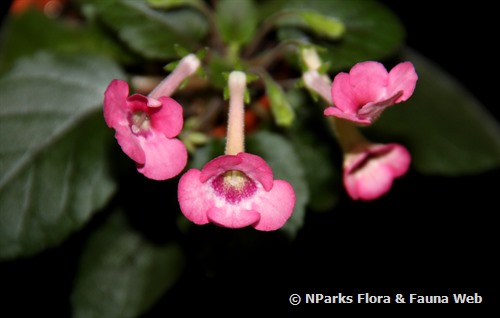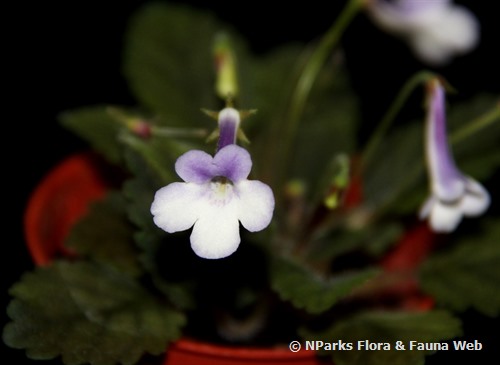.jpg)
Back
Sinningia 'Fat Dragon'
| Family Name: | Gesneriaceae |
Sinningia ‘Fat Dragon’ is a short tuberous herb with hairy egg-shaped leaves and tubular flowers borne on long stems. Flowers are pink with white lower lip, shading to a greenish yellow throat with red markings. Cultivars of Sinningia are popular with plant hobbyists because most are long-lived, easy to grow, and produce flowers that are unusual and attractive.
Name
Classifications and Characteristics
| Plant Division | Angiosperms (Flowering Seed Plants) (Dicotyledon) |
|---|---|
| Plant Growth Form | Herbaceous Plant |
| Lifespan (in Singapore) | Perennial |
Biogeography
| Local Conservation Status | Non-native (Horticultural / Cultivated Only) |
|---|
Description and Ethnobotany
| Growth Form | It is a tuberous herb with shorts stems, giving this species a rosette like appearance. |
|---|---|
| Foliage | Its leaves are egg-shaped, green to olive, covered in soft hairs. The leaves have a toothed leaf margin. |
| Flowers | Its flowers are tubular, attached to a long stem. Flowers are pink with white lower lip, shading to a greenish yellow throat with red markings. |
| Cultivation | Similar to African violets, it prefers to grow in well-drained soil under indirect or filtered light. Ensure that the plant is grown in a small pot, water moderately to prevent soggy soil that will cause the tubers to rot. |
| Etymology | The genus, ‘Sinningia’, is named in honor of Wilhelm Sinning, German horticulturist of the Botanical Garden of the University of Bonn. |
Landscaping Features
| Desirable Plant Features | Ornamental Flowers |
|---|---|
| Landscape Uses | Interiorscape/ Indoor Plant, Container Planting |
Plant Care and Propagation
| Light Preference | Semi-Shade |
|---|---|
| Water Preference | Moderate Water, Occasional Misting, Prefers Cool Environment |
| Plant Growth Rate | Moderate |
| Rootzone Tolerance | Easy to Grow |
| Propagation Method | Leaf Cutting |
Foliar
| Mature Foliage Colour(s) | Green |
|---|---|
| Mature Foliage Texture(s) | Velvety / Furry / Tomentose |
| Foliar Type | Simple / Unifoliate |
| Foliar Attachment to Stem | Petiolate |
Image Repository
Others
| Master ID | 33949 |
|---|---|
| Species ID | 8365 |
| Flora Disclaimer | The information in this website has been compiled from reliable sources, such as reference works on medicinal plants. It is not a substitute for medical advice or treatment and NParks does not purport to provide any medical advice. Readers should always consult his/her physician before using or consuming a plant for medicinal purposes. |

.jpg)
.jpg)


.jpg)
.jpg)